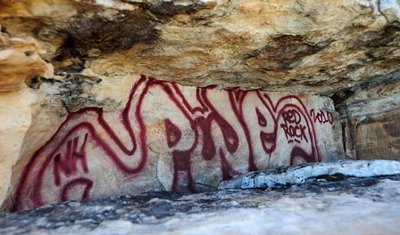
Courtesy Friends of Red Rock Canyon
Damage is shown after vandals used spray paint on historic rock art panels at Red Rock Canyon.
Thursday, June 23, 2011 | 12:44 p.m.
Sun archives
- Police: Ancient Red Rock art vandalized for ‘shock value’ (12-9-2010)
- Police make arrest in Red Rock vandalism case (12-8-2010)
- Police: Red Rock vandalism linked to ‘Nasty Habits Crew’ gang (12-1-2010)
- Vandals hit ancient art at Red Rock (11-29-2010)
The blood-red spray paint found covering ancient rock art panels at Red Rock Canyon Conservation Area in November outraged the community and garnered national attention.
The giant letters obscuring pictographs and petroglyphs signaled a change: Graffiti vandalism had moved from the urban core to a federally protected historic site.
Authorities caught the alleged 17-year-old vandal within a week, but the incident helped spark legislation, effective in October, that carries stiffer penalties for graffiti vandals, especially at protected sites in Nevada.
“Because of the outrage that case caused, we began to look at our existing law to see if there were changes we could make,” said Detective Scott Black of Metro Police’s graffiti investigation section.
State Sen. Valerie Wiener, who introduced the bill, actually began drafting the legislation before the Red Rock incident, the result of what she calls a “lightbulb moment” while visiting a school in her urban Las Vegas district.
A student asked her why graffiti laws are so tough. The question caught her slightly off-guard, as she didn’t consider the laws strict.
“It’s theft,” she told the student. “It’s stealing the value of someone’s property.”
The exchange with the student compelled her to action after years of witnessing graffiti damage in her urban area of District 3, where she once saw graffiti pop up overnight and completely cover a three-block stretch of wall along Valley View Boulevard.
“It kind of wore on me,” she said. “I know what it does to neighborhoods.”
Wiener and other officials began looking at Nevada’s existing graffiti law, as well as laws in other states, to determine what could be added or enhanced to deter the crime.
Officials soon noticed a gaping hole: The federal government was prosecuting the teen who allegedly vandalized Red Rock because it’s a national historic site, but protected state areas, historic sites and landmarks didn’t carry the same weight.
The new law changes that discrepancy. Starting in October, anyone who commits graffiti vandalism on protected sites in Nevada (Valley of Fire State Park, for instance) will be guilty of a class-C felony, a charge that could lead to prison time, Black said.
The law also includes the following changes:
- Multiple instances of graffiti vandalism by one person totaling $500 now will constitute a felony charge, significantly reducing the previous $5,000 threshold to become a felony. (Police said two separate graffiti tags could cross the $500 mark.)
- On third offenses, judges can order vandals to clean up graffiti in a specific area for up to one year.
- A judge could order parents or legal guardians of juveniles convicted of graffiti vandalism to attend and participate in counseling sessions with their children.
- Public or private property owners can sue graffiti vandals for up to three times the cost of restoration, as well as attorney’s fees and costs.
“This legislative change is the most significant step that this state has ever taken in regard to graffiti vandalism,” Black said. “It is basically making it very clear that if you are a graffiti vandal, you are not welcome in the state of Nevada.”
Police constantly grapple with a graffiti problem in Las Vegas, partially because of the city’s worldwide notoriety.
The city tends to attract graffiti vandals who seek that “rush” or “thrill” of defacing property, Black said. Police said the proliferation of the Internet has added to the problem, giving vandals a place to showcase their work — many of whom boldly post videos on YouTube.
“Las Vegas is not only a tourist destination, it’s a graffiti destination,” Black said. “Quite often, we will have investigations of large-scale damage, whether it’s in the tourist corridor or elsewhere in the city.”
Metro arrested more than 750 people for graffiti-related offenses last year, the time frame in which officials spent about $30 million of public and private funds to remove it, Black said.
In the past five years, police have identified more than 500 tagging crews, groups of graffiti vandals, with members of all ages and both genders, Black said.
To curb graffiti vandalism, Metro backed a bill that passed the Nevada Legislature in 2007, which created laws specific to graffiti, Black said. Previous to that, graffiti vandals were charged under a malicious destruction to property statute.
Because fame motivates many graffiti vandals, graffiti-specific laws and stricter penalties are necessary, Black said.
“These guys are organized and their motivation is fame — fame being recognition from their peers,” he said. “They are absolutely dedicated to breaking the law and damaging property; it has nothing to do with art.”
Graffiti vandals often tag signs, walls or structures with letters, otherwise known as their monikers in the graffiti world, police said. The greater the visibility of their monikers, the more satisfaction they derive from the crime.
“I’ve actually arrested a graffiti vandal and on his fourth or fifth arrest, he broke down crying and said he couldn’t stop,” Black said, referring to the addiction component of the crime.
The new law reinforces the state’s zero-tolerance policy toward graffiti, stemming from Nevada’s reliance on tourism and large amount of protected sites and landmarks, officials said.
“You have a community with rampant graffiti, you are going to have rampant crime,” Black said. “That’s why it’s a wonderful thing for the citizens for the state of Nevada that we’re essentially declaring a war on graffiti.”


Join the Discussion:
Check this out for a full explanation of our conversion to the LiveFyre commenting system and instructions on how to sign up for an account.
Full comments policy